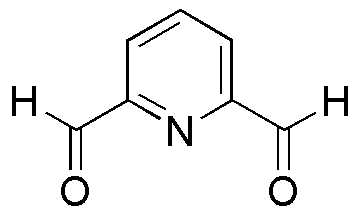2,6-Pyridinedicarboxaldehyde is widely utilized in research focused on:
- Synthesis of Pharmaceuticals: This compound serves as a key intermediate in the synthesis of various pharmaceutical agents, particularly those targeting neurological disorders.
- Ligand Development: It is employed in the creation of coordination complexes with metals, which are crucial in catalysis and materials science.
- Fluorescent Probes: The compound is used to develop fluorescent probes for bioimaging applications, enhancing the visualization of cellular processes.
- Organic Synthesis: It acts as a versatile building block in organic synthesis, allowing chemists to construct complex molecules efficiently.
- Research in Agrochemicals: This chemical is explored for its potential applications in developing agrochemicals, contributing to advancements in sustainable agriculture.
General Information
Properties
Safety and Regulations
Applications
2,6-Pyridinedicarboxaldehyde is widely utilized in research focused on:
- Synthesis of Pharmaceuticals: This compound serves as a key intermediate in the synthesis of various pharmaceutical agents, particularly those targeting neurological disorders.
- Ligand Development: It is employed in the creation of coordination complexes with metals, which are crucial in catalysis and materials science.
- Fluorescent Probes: The compound is used to develop fluorescent probes for bioimaging applications, enhancing the visualization of cellular processes.
- Organic Synthesis: It acts as a versatile building block in organic synthesis, allowing chemists to construct complex molecules efficiently.
- Research in Agrochemicals: This chemical is explored for its potential applications in developing agrochemicals, contributing to advancements in sustainable agriculture.
Documents
Safety Data Sheets (SDS)
The SDS provides comprehensive safety information on handling, storage, and disposal of the product.
Product Specification (PS)
The PS provides a comprehensive breakdown of the product’s properties, including chemical composition, physical state, purity, and storage requirements. It also details acceptable quality ranges and the product's intended applications.
Certificates of Analysis (COA)
Search for Certificates of Analysis (COA) by entering the products Lot Number. Lot and Batch Numbers can be found on a product’s label following the words ‘Lot’ or ‘Batch’.
Numéro de catalogue
Numéro de lot/série
Certificates Of Origin (COO)
This COO confirms the country where the product was manufactured, and also details the materials and components used in it and whether it is derived from natural, synthetic, or other specific sources. This certificate may be required for customs, trade, and regulatory compliance.
Numéro de catalogue
Numéro de lot/série
Safety Data Sheets (SDS)
The SDS provides comprehensive safety information on handling, storage, and disposal of the product.
DownloadProduct Specification (PS)
The PS provides a comprehensive breakdown of the product’s properties, including chemical composition, physical state, purity, and storage requirements. It also details acceptable quality ranges and the product's intended applications.
DownloadCertificates of Analysis (COA)
Search for Certificates of Analysis (COA) by entering the products Lot Number. Lot and Batch Numbers can be found on a product’s label following the words ‘Lot’ or ‘Batch’.
Numéro de catalogue
Numéro de lot/série
Certificates Of Origin (COO)
This COO confirms the country where the product was manufactured, and also details the materials and components used in it and whether it is derived from natural, synthetic, or other specific sources. This certificate may be required for customs, trade, and regulatory compliance.


